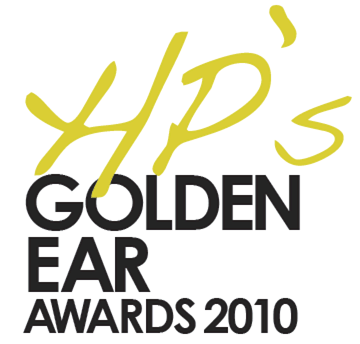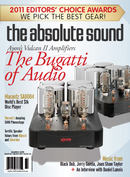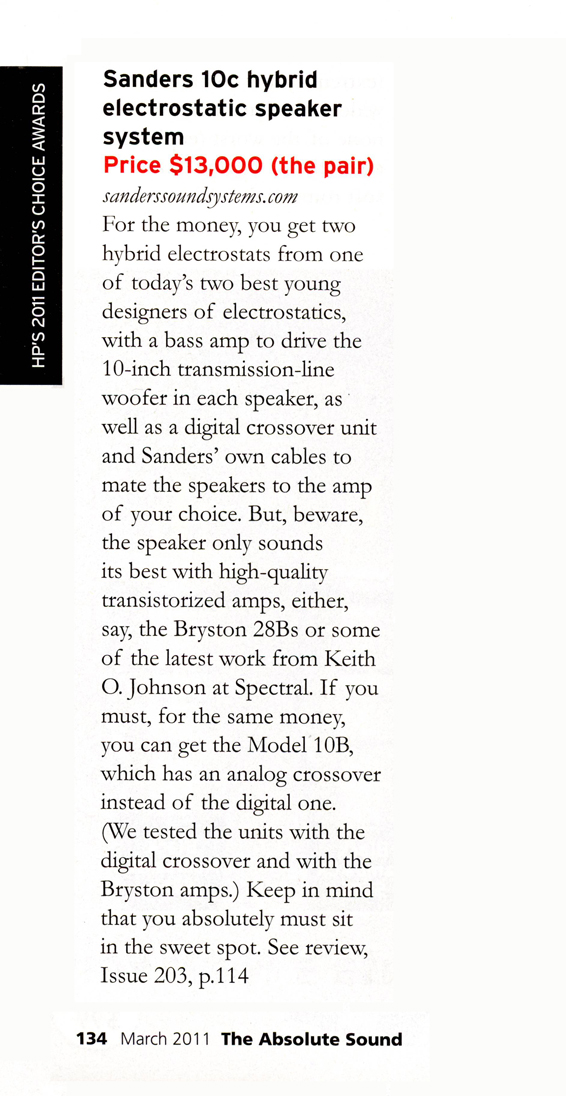Sanders 10e Review - The Absolute Sound - Robert E. Greene
Sanders Model 10e Hybrid Electrostatic Loudspeaker
A Different Approach to Speaker Design
This is a short exerpt - To read the entire review, please click on title above ^

The Sanders Model 10e is the culmination of decades of work by designer Roger Sanders towards perfecting hybrid electrostatic design. And a culmination it is, indeed. This is one of the best speakers ever made. Forget that the price of it is modest by contemporary standards for speakers aspiring to be as good as possible. Within its design brief of producing a relatively narrow radiation pattern that emphasizes direct sound, the Sanders 10e’s are as close to perfection as any speaker system I have ever encountered, outside of installations where room and speakers were purpose-built as a unit. For domestic purposes, you can spend a great deal more money, but I do not think that you can buy a better speaker if this type of radiation pattern is your sonic goal. . .
. . . The review that follows is going to be analytical. A speaker that sounds this wonderful tempts one to go all gushy with adjectives—I shall do this a bit near the end. But mostly I am going to describe as well as I can how the Sanders speakers do what they do, my ideas of why they work so well, and what the results are literally. This is a serious speaker design, one of the most serious, and it deserves a serious description, not just some sort of golly gee-whiz write-up or salesmanship package. But be assured that in my view the Sanders are a benchmark of speaker design, a design that is superb in all respects and in some respects raises speaker design to a level never reached before. As conventional drivers have improved, new possibilities of excellence have opened up for box speakers made with cones plus tweeters. Some of these are wonderful and are very satisfying musically, especially if one is willing to listen to them at close range to get rid of room effects.But the Sanders offers things that no speaker can really do unless it has a large enough radiating area to make it directional, as I shall explain. Please just take the “golly gee whiz” for granted, and let us get down to the serious business of what this speaker actually does. . .
. . . But if you wanted to call the Sanders 10e the best speaker ever, you could definitely make a case. Within the category of speakers that emphasize facsimile reproduction of the direct arrival, the Sanders system can surely claim to be the equal of any and far superior to most. And when you consider that even if you buy two Sanders Magtech amplifiers—one comes along as part of the $17,000 package—the total cost exclusive of source components is $22,500, and that you can adjust the speaker to suit your room and your tastes, this system seems to me to be not only a wonder but also a bargain. tas
The Absolute Sound - 2016 Golden Ear Award - Model 10e Speaker System August 2016

The Absolute Sound’s 2016 Golden Ear Awards
Robert E. Greene
Sanders 10e Speaker System and Magtech Amplifier
$17,000, including one amplifier ($5500 for additional amplifier)
This latest version of Roger Sander’s longtime work on electrostatic speakers is a great triumph of audio design. The system is in many ways all but incomparably good, exploring the boundaries of what is possible in audio now or in the foreseeable future. And when one considers the reasonable price, the achievement becomes even more startling and impressive. The speakers, electronic (DSP) crossover from DBX, and a Magtech amplifier are sold together as a unit for $17,000. Another amplifier is needed—the system is intrinsically bi-amplified—and if one adds in another Magtech, the complete system cost is $22,500. For this, you get one of the most accurate home playback systems available at any price. Moreover, you get a system which includes digital room correction and a wide variety of DSP options that allow users to tailor response to room conditions and specific recordings. This is a system which is both superb as it stands and highly flexible as well. The system is a hybrid of transmission-line dynamic woofer in the bass and a flat electrostatic panel above the bass. The electrostatic panel is very low in distortion—as one expects from electrostatics—but is also unexpectedly robust, and the speakers are capable of very high volume levels. Bass is very extended and precise and via DSP room correction (included with the crossover unit), extremely smooth and free of room effects. The electrostatic panels are essentially flat in overall balance and non-resonant by nature, but in addition they are eq’d to be ultra-flat using DSP. This is one of the lowest coloration speakers in existence. The size and shape of the electrostatic panels minimizes floor and ceiling bounce, and the dipole radiation pattern of the panel and its width mean that one can all but eliminate early reflections off the sidewalls. The speakers’ direct output will be almost all you hear above the bass until the sound off the backwall arrives, delayed by 10 milliseconds or more with suitable positioning of the speakers. You will thus get effectively the sound—an ideal to my mind—of an RFZ (reflection-free zone) room without needing to build one. People accustomed to hearing their own room’s sonic signature laid over every recording may find this takes a little getting used to. But the advantages are very striking. Imaging is spectacularly precise and three-dimensional, when the recording justifies that. One has a sense of hearing into the recording venue that is hard to attain otherwise. And the ultra-neutrality really makes instruments sound right. On its own terms (of controlled radiation pattern), the Sanders 10e system sets a new benchmark in speaker design. (Review forthcoming)
Dagogo - Model 10 Electrostatic Speaker Review - September 2013
Sanders Sound Model 10 Electrostat Speaker Review
By: Laurence A. Borden | September 2013
. . . The advantages enumerated above are far more than theoretical. Listening to music – importantly, any type of music – through the Model 10’s revealed unrivaled clarity. Instruments and voice were portrayed with breathtaking detail in virtually every parameter: tonality, rise time, texture, shading, harmonics, etc. By comparison, most every other speaker with which I am familiar sounds muted, colored, and sluggish. The amount of musical information provided by the Models 10’s allows a far greater appreciation of the music and sense of realism, as compared to most other speakers through which so much information is obscured. A number of years ago, when I was affiliated with another magazine, I wrote an article entitled “Real or Surreal,” in which I spoke of the common practice of speaker manufacturers intentionally boosting certain frequencies, to give the illusion of detail. Ultimately, such speakers become fatiguing, and lend a sameness to all recordings played through them. The Model 10’s are the antithesis of this; they have a very flat frequency response, and provide gobs of information throughout the entire frequency range. In point of fact, the Model 10’s are amongst the most evenly balanced speakers I have heard. They are neither warm, nor harsh. Instead, they provide an incredibly clear and uncolored window into the music, in which every instrument is heard clearly, cleanly and distinctly. They allow the listener to hear and comprehend the pace and nuance of the performers, and this is true for all types of music. . .
. . . Moreover, they are capable of sustained play at so-called “concert levels.” But the Models 10’s do more than just play loud; they go from soft to loud in the blink of an eye, and thereby reproduce the music’s energy and dynamics. . .
Conclusions
In the opening paragraph I said that at RMAF I had spoken to Roger about obtaining a pair of Model 10’s for review. That was only a half-truth. In point of fact, what I told Roger was that I wanted to purchase a pair of Model 10’s, and that I would write a review of them. So yes, the “review pair” is, in fact, mine. In the months I have had them, they have re-defined my sense of high-end audio, and brought hour after hour of musical listening pleasure, to both myself and many of my friends and colleagues. My only regret is not having purchased them years ago. The Sanders Sound Model 10’s are amongst the finest speakers I have heard, and certainly the best I have owned. At their price of $14,000 including a stereo amp and active crossover, they are also one of the greatest deals in high-end audio. They unequivocally earn my highest recommendation.
TAS - Model 10c's receive HP’s GOLDEN EAR AWARD June 2010

Sanders Model 10c Hybrid Electrostatic Speaker System
(click here to see PDF of award)
Roger Sanders' new speaker system strikes me as being a remarkable achievement, with much of the potential of a thought-through electrostatic design and few of its inherent disadvantages. True, it is a hybrid system, with a 10-inch transmission-line woofer on each side, slyly mated (at a low frequency, 172 Hertz) to the 'stat panels. But those woofers, driven by Sanders' own 350-watt solid-state amp, are capable of pressurizing a room in ways that almost no full-range electro stat working solo can, and, more to the point, these 'stat panels can be played at virtually any level you choose (at least short of incurring hearing loss), even with Bryston's 1000-watt mono blocks. Moreover, the transition between the woofers and the 'stats is surprisingly seamless, so that this system sounds more like a coherent whole than such matings almost always do.
Of course, you have to sit in the sweet spot-the apex of an equilateral triangle opposite the two canted-in speakers-in order to fully realize its potential (its headphone-like nature drove my assistant, Joey Weiss, to call it "a selfish speaker"). But Sanders argues that such a narrowly defined "center" listening spot is essential if the proper phase relationships of a musical signal are to be correctly rendered. That is, if the imaging is to be both fixed and focused. And he will (in an upcoming interview) go into some detail on placement and room problems. For example, he is opposed to passive bass absorbers because of the way they mar correct phase reproduction.
Sanders also adamantly opposes the use of tubed or tube-based amplifiers with this system. An electrostatic speaker acts essentially as a capacitor, and as the frequencies go up, an amp's output impedance must go down, or the top octaves will be lost. Which leaves you with the "warm" midrange so prized by hi-fi addicts. HP (that's me) used to believe that tubes would sound best with 'stats, but found out the hard way that this simply is not the case, and this before reading Sanders' tech papers on the topic.
More specifically, using a wonderful Linn recording of Bach's Goldberg Variations [Matthew Halls, Linn CKD 356] on the reference Scaenas, I found the harpsichord reproduction for the first time particularly true to the sound of the instrument itself. I supposed, at first, that with the ultra-resolution of the Sanders, this sound might just be, if anything, more delicately natural. But when the Sanders were mated with a tubed unit we had in house (which shall go unnamed not because it isn't good, but because of the mismatch), the harpsichord didn't sound "authentic" at all, but colored, most hi-fi-like. In other words, Technicolored in the mids and missing the airy overtones in the highs that distinguished dUs particular instrument. So it was out with the tubes and in with the transistors. First, a unit of Sanders own design, and, then for the ultimate in power (which the 10s can take), we inserted the stunningly uncolored (read: no transistor signature) update to the Bryston 28Bs. It has an output impedance of 0.02 ohms, rising slightly (to 0.03 ohms) at 20kHz. And the sound, from the harpsichord to full orchestra, went from transparent to the verge of translucency.
The top octave of the Brystons, as mentioned elsewhere, is particularly open and this lets you hear into the sound field in an almost unique way, thanks to a much larger power supply and more sophisticated capacitors. And on the big stuff, especially the minimally miked big stuff, the exact positioning of instruments, in a field of remarkable depth, was unimpeachable. And one more thing that became apparent, especially to a veteran listener who dropped by for a session, was the speakers' ability to recreate a sense of the vertical height of a soundstage.
Some may find the highly revealing sonics disturbing, especially if they've been bred and buttered, over the years, on "hi-fi" colorations. And I shall have much more to say on the topic. And on this speaker system. Price: $13,000. (This includes a digital crossover and the separate amp that drives the bass units, as well as Sanders-designed cables to match the 'stats to the amp of your choice. There is also a Model lOB, with an analog crossover, which itself includes the amp to drive the bass. Same price.)
Designer: Roger Sanders.
Contact: sanderssoundsystems.com
To see the award, please see The Absolute Sound Issue #203 at this link
http://www.avguide.com/magarchive/theabsolutesound/2010



